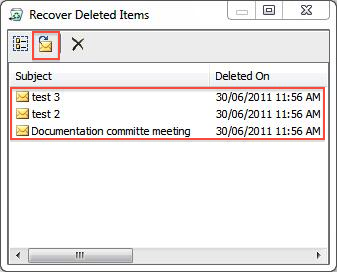Recover Deleted Items In Outlook For Mac 2016

See attached picture. Follow the numbers. With the top box of #5 checked, email gets deleted from the INBOX, but it does not go to the Deleted Items folder.They seem to just disappear, both in outlook and on our Smartermail server. How can the answer be improved?
Outlook Web App When you accidentally delete an item from your mailbox, you can often recover it. The first place to look for a deleted item, such as an email message, calendar appointment, contact, or task is the Deleted Items folder.
If it's not there, you might still be able to recover it by using Recover deleted items, depending on settings that are controlled by your IT administrator. This article is for Outlook Web App, which is used by organizations that manage email servers running Exchange Server 2013 or 2010. If you're using Office 365 or Exchange Server 2016, your email program is Outlook on the web.
For help with Outlook on the web, see. When you delete an email message, contact, calendar item, or task, it's moved to the Deleted Items folder. • In a web browser, sign in to Outlook Web App using the URL provided by the person who manages email for your organization. Enter your user name and password, and then select Sign in. • In your email folder list, select Deleted Items.
• To restore an email message, do one of the following: • To restore a message to your inbox, right-click the message, then select Move > Inbox. • To restore a message to a different folder, right-click the message, then select Move > More. Choose a folder location and then select Move.
• To restore other types of items: • To restore a contact, right-click it, then select Move to Contacts. • To restore a calendar item, right-click it, then select Move to Calendar.
 Use the iOS App to input the data during the day and analyze your data on your desktop. New Feature: - Possibility to add own graphs, based on existing available plots. So your data is accessible on all your devices.
Use the iOS App to input the data during the day and analyze your data on your desktop. New Feature: - Possibility to add own graphs, based on existing available plots. So your data is accessible on all your devices.
• To restore a task, right-click it, then select Move to Tasks. Tips for recovering items in your Deleted Items folder • If you delete a folder, it's moved to the Deleted Items folder and appears as a subfolder. To recover it (and all the items it contains), right-click the deleted folder, select Move, and then select a folder to move it to. • Your admin might have set up a policy to delete items from your Deleted Items folder after a certain number of days. Just like when you deleted an item, items deleted by a policy are moved to the Recoverable Items folder. So if you can't find something in your Deleted Items folder, look for it in the Recoverable Items folder. If you can't find an item in the Deleted Items folder, the next place to look is the Recoverable Items folder.
This is a hidden folder that items are moved to when: • They're deleted from the Deleted Items folder. • The Deleted Items folder is emptied, either by you or by a policy set by your IT administrator. • You delete an item by selecting it and pressing Shift+Delete.
To view and recover items that have been moved to the Recoverable Items folder: • In a web browser, sign in to Outlook Web App using the URL provided by the person who manages email for your organization. Enter your user name and password, and then select Sign in. • In your email folder list, right-click Deleted Items, then select Recover deleted items. • If necessary, use the search box to find the item you want to recover. • When you find the item, select it, and then select Recover.
Recovered items are moved to the default location for each item type. • Messages go to your Inbox. • Calendar items go to your Calendar.
• Contacts go to your Contacts folder. • Tasks go to your Tasks folder. Tips for recovering items in your Recoverable Items folder • The deleted date for an item in the Recoverable Items folder is when the item was moved to the Deleted Items folder. It's not the date the item was moved to the Recoverable Items folder. • Items in the Recoverable Items folder don't have icons, so they all look very similar. • If you're looking for a contact, look for an item that has the name of the person, but no subject line. • If you're looking for a calendar appointment, look for an item that doesn't have a person's name or a subject line.